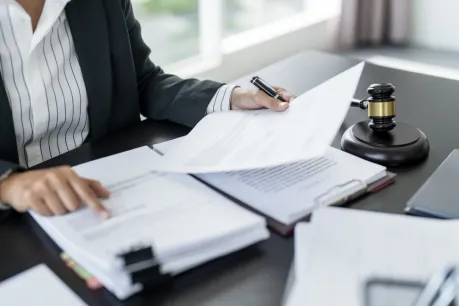What Is a Multidistrict Litigation (MDL)?

Injured?
When dozens, hundreds, or even thousands of people across the country file lawsuits involving the same product, company, or event, the legal system faces a major challenge: how to handle them efficiently without duplicating efforts or producing conflicting rulings. That’s where multidistrict litigation (MDL) comes in.
At Morgan & Morgan, we are proud to represent everyday people in some of the most complex MDL cases in the country. From dangerous pharmaceutical drugs to defective medical devices and corporate misconduct, we help clients navigate the MDL process and fight for the justice and compensation they deserve.
Every case is unique, and to determine if yours is best served by a Multidistrict Litigation, you can contact Morgan & Morgan to learn more. Our legal team can review the details of your claim and advise you on your next steps with a free case evaluation.
What Is Multidistrict Litigation (MDL)?
Multidistrict litigation (MDL) is a legal procedure used in federal court to consolidate civil cases that share common factual issues. Rather than handling hundreds of similar cases separately in courts all over the country, the federal judiciary brings them together under one judge for pretrial proceedings. The goal is to improve efficiency, avoid inconsistent rulings, and streamline discovery and evidence collection.
MDLs typically involve cases like:
- Dangerous drugs or defective medical devices
- Airline or train disasters
- Consumer product defects
- Securities fraud
- Data breaches and privacy violations
- Environmental disasters or toxic exposure
Each individual case in the MDL remains separate for purposes of trial and resolution, unlike a class action, where the plaintiffs are treated as one group. If the MDL doesn’t reach a global settlement, cases may be sent back to their original courts (a process called remand) for trial.
How Does an MDL Start?
The process begins when several civil cases involving similar issues are filed in federal courts across the country. If the number of cases grows, the parties involved or a judge may ask for those cases to be centralized through a process overseen by the Judicial Panel on Multidistrict Litigation (JPML).
The Role of the JPML
The JPML is a special panel of seven federal judges who decide whether cases should be consolidated and, if so, where the MDL will be located. The panel holds regular hearings and considers several factors:
- Do the cases share common factual questions?
- Would centralizing the cases promote convenience and efficiency?
- What district and judge would be most appropriate?
If the panel approves the request, they issue a transfer order consolidating the cases into a single MDL proceeding under one judge.
What Happens After Cases Are Consolidated?
Once an MDL is formed, the centralized litigation process begins. Here's what that typically includes:
1. Pretrial Proceedings
This is the heart of the MDL process and includes all the early stages of litigation, such as:
- Discovery: Both sides gather evidence, depose witnesses, and exchange documents.
- Motions: The parties may file motions to dismiss, motions for summary judgment, or other requests for rulings.
- Science and Experts: In many MDLs, scientific or medical experts are crucial. The court may hold Daubert hearings to determine whether expert testimony is reliable and admissible.
2. Bellwether Trials
MDL courts often schedule a small number of representative trials, known as bellwether trials, to test how juries react to the evidence. These trials are selected to reflect a range of issues seen in the broader group of cases and can guide future settlement negotiations.
3. Settlement Negotiations
If the results of bellwether trials favor the plaintiffs or if the parties see the writing on the wall, they may engage in large-scale settlement discussions. Some MDLs resolve with a global settlement, while others may settle on a case-by-case basis.
4. Remand for Trial
If no settlement is reached, individual cases may be sent back or remanded to their original federal court to proceed to trial.
What’s the Difference Between an MDL and Class Action?
Although multidistrict litigation (MDL) and class action lawsuits are both designed to efficiently manage large numbers of similar legal claims, they differ significantly in structure, participation, and case resolution. In an MDL, each plaintiff files and maintains their own individual lawsuit. These cases are consolidated for pretrial proceedings, such as discovery and motions, but remain separate and may be sent back to their original courts for trial if no settlement is reached. This structure allows each plaintiff to retain control over their case, including decisions about settlement or trial.
In contrast, a class action combines many plaintiffs into a single lawsuit, typically represented by one or a few lead plaintiffs who act on behalf of the entire group. The court must certify the class, and once approved, all individuals who fall within the defined group are automatically included unless they actively opt out. This means that most class members do not participate directly in the litigation or decision-making process. Instead, any settlement or verdict is distributed among all members of the class according to a court-approved plan.
Another key difference lies in how damages are determined. In MDLs, compensation is typically based on the specific facts and injuries of each plaintiff’s case, which can lead to more personalized outcomes. In class actions, damages are often calculated on a uniform basis and split among the class, which may result in smaller individual payouts. While both legal tools serve the goal of efficiency, MDLs tend to offer greater flexibility and control for plaintiffs with significant or unique injuries, whereas class actions are generally more streamlined and better suited for cases where individual differences are minimal.
Notable MDLs in the U.S.
Some of the largest and most impactful lawsuits in American history have been MDLs. Here are a few examples:
3M Combat Arms Earplugs
Thousands of U.S. veterans filed lawsuits alleging that 3M’s defective earplugs caused hearing loss and tinnitus. This MDL became the largest mass tort in U.S. history, with nearly 300,000 cases at its peak.
Opioid Litigation
Cities, counties, and states sued drug manufacturers and distributors for their role in the opioid epidemic. These lawsuits were consolidated into an MDL, resulting in multibillion-dollar settlements from companies like Purdue Pharma, Johnson & Johnson, and McKesson.
Talcum Powder Lawsuits
Consumers alleged that Johnson & Johnson’s talcum powder products caused ovarian cancer or mesothelioma. Many of these federal lawsuits were consolidated in MDL No. 2738 in New Jersey.
Roundup Weed Killer
Thousands of lawsuits claimed that Bayer’s Roundup herbicide, which contains glyphosate, caused non-Hodgkin’s lymphoma. After major jury verdicts, Bayer agreed to settle a large portion of the litigation.
How Do I Know if I Have an MDL Case?
If you’ve been harmed by a widely used product, drug, or company practice and you’ve seen others in similar situations, you may be part of a potential MDL. Here’s how to find out:
- Search the U.S. JPML website to see if an MDL already exists.
- Contact an experienced attorney at a firm like Morgan & Morgan.
- Watch for TV, social media, or news reports announcing mass torts or ongoing litigation.
Even if an MDL already exists, you must still file your own case. Unlike a class action, you aren’t automatically included.
The Pros and Cons of Joining an MDL
Is an MDL the way to go? It depends on numerous factors, and every case is unique. Here’s a list of pros and cons.
Pros:
- Greater efficiency and speed
- Access to shared resources and expert testimony
- Increased bargaining power in settlement discussions
- Avoidance of inconsistent court rulings
Cons:
- Less individual control than in a standalone case
- Long timelines in some MDLs
- Potential for smaller settlements if the MDL resolves globally
Each situation is different, so it’s critical to speak with an attorney to determine whether joining an MDL is right for you.
Why Work With a Firm Like Morgan & Morgan?
At Morgan & Morgan, our mass tort and MDL attorneys have decades of experience handling complex cases involving dangerous drugs, defective products, corporate negligence, and more.
As the nation’s largest personal injury law firm, our clients trust our track record of results, having secured over $25 billion in compensation, and our vast resources to match—we invest in top-notch experts, investigators, and trial attorneys to build your case.
And with offices in every state across the country, we can handle MDL cases no matter where you are.
Our team is involved in many current and emerging MDLs, and we know how to guide clients through every step, from filing their case to negotiating a fair settlement or going to trial.
Do You Have a Case?
If you believe you’ve been harmed by a product, drug, or corporate action that’s part of an MDL or may soon be, talk to us today. The sooner you speak with an attorney, the sooner you can understand your rights and protect your claim.
At Morgan & Morgan, we have the resources, experience, and determination to take on even the largest corporations. Despite our size, you’re not just another number to us. You’re a person who deserves justice, and for over 35 years, we have always fought For the People.
Contact us today for a free, no-obligation case evaluation to learn more about your legal options.

We've got your back
Injured?
Not sure what to do next?
We'll guide you through everything you need to know.